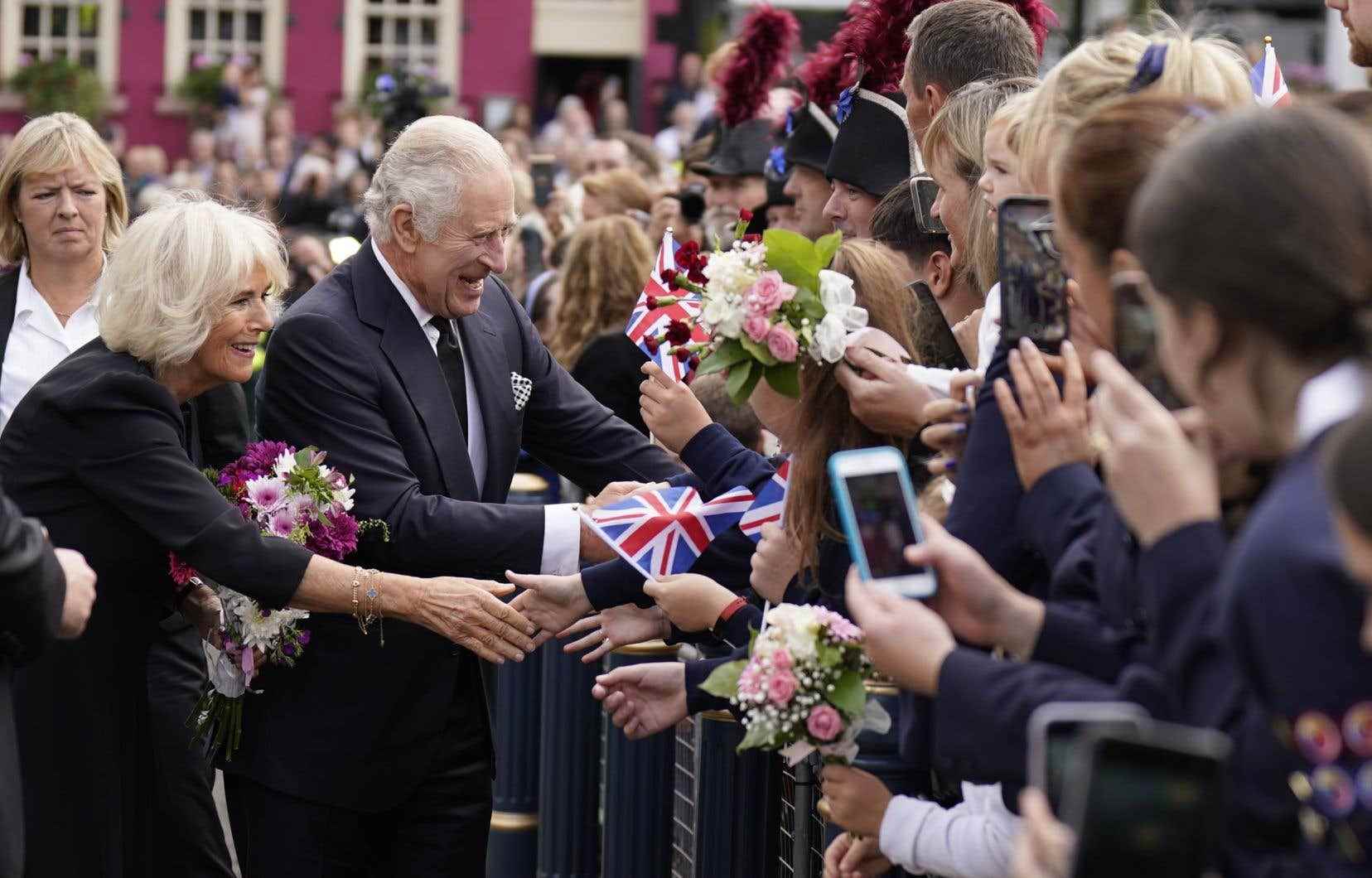For his first visit as monarch, Charles III promised on Tuesday to serve “all the inhabitants” of Northern Ireland, plagued by community tensions as he succeeds Elizabeth II in an atmosphere of popular fervor and national emotion. .
The sovereign had played a major role in reconciliation in the province with a bloody past. But nearly a quarter of a century after the return of a fragile peace between Republicans, especially Catholics, and Unionists, mainly Protestants, tensions have been reignited by Brexit, reviving the idea of a separation from the United Kingdom and of reunification with Ireland.
Arrived from Edinburgh, where they joined the tens of thousands of people gathering at the coffin of Elizabeth II, Charles III and Queen Consort Camilla went into contact with the public massed in front of Hillsborough Castle. They shook hands for a long time, greeted the children, exchanged a few words: images that were hard to imagine at the time of the “Troubles”.
“With a shining example before me, and with the help of God, I take up my new duties, determined to seek the well-being of all the people of Northern Ireland,” the monarch told the local Parliament, at the stopped for months.
Politically paralyzed and in upheaval under the effect of the victory in the last elections of the Republicans of Sinn Féin, who do not recognize the authority of the monarchy, Northern Ireland remains the most delicate stage of the tour started by the new king in the four constituent nations of the United Kingdom.
He visited the British Parliament in London on Monday, then that of Edinburgh, before going to Cardiff, Wales, on Friday.
“It’s reassuring to see the communities rally behind the new king,” observes Ann Sudlow, retired, who welcomes a certain unity in the province, like the emotion that has gripped the country since the Elizabeth II died last Thursday at the age of 96.
Elizabeth II’s coffin in London
Five days after her death in Scotland, the remains of Queen Elizabeth II arrived Tuesday evening to the applause of the crowd at Buckingham Palace in London, where she was welcomed by King Charles III.
After being exposed to the public for the first time for 24 hours in Edinburgh, Scotland, the royal coffin was escorted by an almost continuous guard of honor, formed by thousands of anonymous people along the road between London airport and Buckingham Palace, where he will spend the night before joining Westminster Hall on Wednesday.
Then will begin the second part of presentation to the public, London this one, which should see hundreds of thousands of people parade for a little less than five days, 24 hours a day. Some started queuing on Monday.
In Edinburgh, tens of thousands of people had waited for hours, including at night, to meditate, bowing, curtsying or making the sign of the cross, or even wiping away a tear in front of the coffin which rested in the cathedral Saint -Gilles.
Placed on a dais and covered with the yellow, red and navy standard of Scotland, a wreath of white flowers and the solid gold crown of Scotland resting above, the coffin remained accessible throughout the night.
King Charles III and his three siblings — Princes Andrew and Edward, as well as Princess Anne — came Monday evening with Queen Consort Camilla to observe a wake. The photo of the children of Elizabeth II, with their backs to the coffin, made the front page of all the daily newspapers on Tuesday.
Coming from Glasgow early Tuesday, Nataliya Dasiukevich, 46, from Russia, says she is in a “very gloomy mood” and is struggling to hold back her tears. “I was not born in this country and I am far from my family. The queen was the closest thing a grandmother has to my child. »
The Queen’s state funeral will take place on Monday attended by some 500 foreign dignitaries and many crowned heads. But Russia, Belarus and Myanmar were not invited.
A royal transition full of challenges
The body of Elizabeth II had until Monday evening been kept away from the general public: first at Balmoral Castle, in the north of Scotland, where the monarch died, then at the royal palace. of Holyrood.
A popular figure, a rock of stability in the political, social or health storm during COVID-19, the queen was a reassuring image for millions of Britons during her decades on the throne.
Tensions in Northern Ireland, separatist desires in Scotland, galloping inflation: the new 73-year-old king, older than all the British sovereigns when they acceded to the throne, takes office at a critical moment. The country, in the grip of a serious social and political crisis, has had a new prime minister for a few days.
The king will probably have to face the claims of some of his 14 other kingdoms (including in particular Australia, the Bahamas, Canada, New Zealand or even Jamaica) which could be tempted by a republican regime, thanks to this change of ruler.
“I believe that’s the direction New Zealand will go at some point, I believe it’s likely to happen in my lifetime, but I don’t see it in the short term,” said the New Zealand Prime Minister Jacinda Ardern.
For his part, if he announced a public holiday on September 19 for civil servants on the occasion of the funeral of the late sovereign, Justin Trudeau refused on Tuesday to give his opinion on the idea of reviewing the role of the monarchy in the Canada, judging that Canadians talk to him more about the rising cost of living, global inflation and the war in Ukraine.
With Duty
